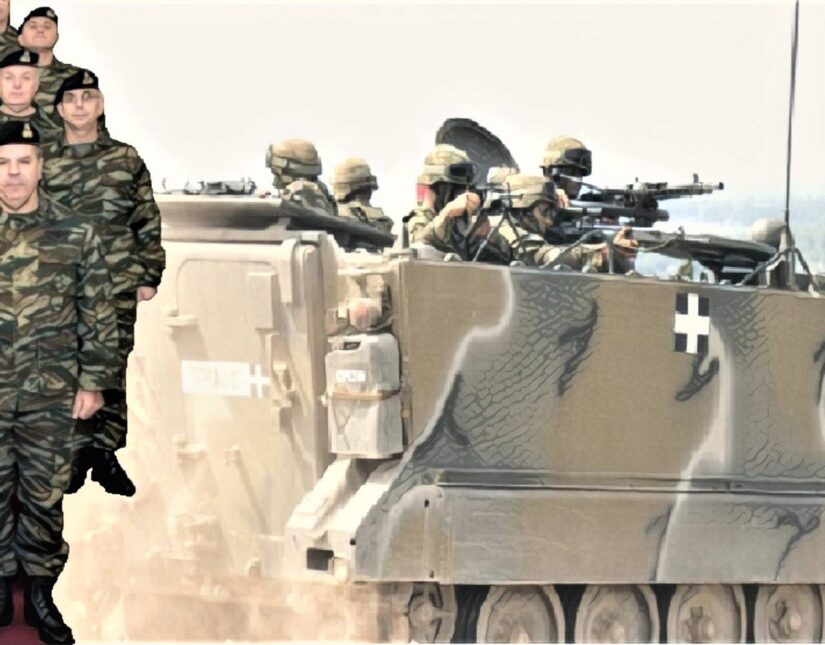Panagiotis Gartzonikas: Rafale fighters are fine and dandy, but we have an Achilles heel in the Aegean …
23/01/2021
The public debate on defense issues focuses on issues of international relations and diplomacy on the one hand, and technical and tactical issues on the other. There are numerous articles on Turkey, Armenia, and the Kurds, as well as on the type of frigates and the characteristics of the Rafale. However, between high politics and the range of the MICA missiles, there is an intermediate space that draws little public discourse.
An important issue, which does not get the attention it deserves, is that of the administration and control of the armed forces in the Aegean. The Aegean is a single space. We have the coexistence of marine and terrestrial environments. The Greek defense idea of actions against the Turkish threat, suffers mainly from the view of the unity of the Aegean and consequently of the administration and control regulations. There are basic weaknesses for assault and amphibious forces, but they will not concern us here.
The Aegean requires a naval commander, who will have under his command both the naval and land forces of the islands and of course the responsibility of defense. The Army and the Navy, moving in their traditional roles, see their role entrenched in the element that dominates each branch. The Army conveyed its perception of conducting operations from the land area to the islands.
Because of this, the logic of the defense there is similar to that of the fortified site. The forts, ie the islands, are manned and defended when attacked. The Navy is only concerned with the sea and considers everything related to land to be foreign. However, the Turkish threat has created a unique situation, which after 35 years of experience, we must deal with more effectively.
The American example to avoid 1942
Due to the inability to escape from traditional conventional roles, we maintain the irrational situation, two commanders in the same area, each conducting his own war! Maintaining the current situation in the Aegean has the following consequences:
First, we are violating the principle of “Unity of Command”, which is not satisfied in this case at the level of the general. Proportionally, it is as if we have two separate commanders for a sector, one for the forts (islands), and one for the space between them (sea). There is no single command, which will choose between different options, set priorities, transfer forces from one point to another, or gather all available means to achieve an objective. The unity of effort, cooperation, and coordination of the two commands is not enough. It is necessary to be subordinated to a commander of all forces and means, who has the appropriate authority and responsibility.
The example of the Pacific administration in World War II is instructive. In 1942, after five weeks of consultations, the US Chiefs of Staff decided to divide the Pacific into two theaters: General MacArthur was appointed commander of the Southwest Pacific region, which included the Philippines, Australia, and the larger islands while Admiral Nimitz commanded the rest of the ocean. Each of the two commanders recruited officers from the respective branch for his staff.
Such a decision was the result of a compromise, as the Navy refused to place the Fleet under the command of anyone other than an admiral, and for MacArthur it was inconceivable that he be placed under the command of an admiral. With two administrations in the Pacific, control of the entire theater was transferred to the shoulders of the Chiefs of Staff. This division received a lot of criticism even during the war.
After the war, MacArthur himself, who was the main cause of the division of the Pacific, admitted: “Of all the wrong decisions in the war, the most inexplicable was the failure to unify the command in the Pacific … The failure to unify the command cannot be based on logic, theory, or even the common mind. Other motives led to such a settlement. The result was the squandering of efforts, the squandering of forces by their diffusion and doubling, and the consequent prolongation of the war with additional losses and costs. ”
In the case of the Aegean, its division must be attributed to motives other than “logic, theory and common sense.” The comparison with the Pacific becomes even more unfavorable for the Aegean for two additional reasons: on the one hand the dimensions of the Pacific are huge, on the other hand in the Aegean we do not have two distinct areas of operations next to each other but one inside the other.
Joint operational Area
Second, today there are no distinct and “clean” roles between operations as in the past. After the end of the Cold War, the naval forces of even large countries turned their attention from oceans to coastal areas, to support inter-branch operations, whose main effort is on land. In other words, there is a shift from operations on the sea, which are equivalent to maritime control operations, to operations from the sea, which are equivalent to force projection operations, such as amphibious operations.
Even the fundamental naval role, maritime control, the US Navy argues, is achieved by “having islands, choke points, peninsulas and bases along coastal areas.” The British Navy, which maintains its commitment to the naval spirit, in its basic textbook on dogma, does not refer to naval power, but to the naval dimension of inter-branch operations. “A fighter jet or an army infantry battalion can easily be an integral part of a naval force because the word ‘naval’ refers to the environment in which they operate and not to the branch of the armed forces from which they come,” it said.
In the “pre-joint operations era” the term “area of operations” referred to land forces. With the introduction of the term “Joint Operations Area”, it now refers to NATO as a land or naval area. The term “operational control” now refers to administrations that dominate a dimension or area, regardless of the Sector from which the units operating in that dimension originate. After all, if we intend to implement modern operational concepts of Antiaccess – Area Denial (A2 / AD) in the Aegean, without waiting for the enemy to land on the coast, then a unified command is a prerequisite.
A comprehensive approach
Third, with the current division of the Aegean in two, the Chief of the Armed Forces General Staff (GEETHA) becomes head of the General Directorate of Operations. That is, the strategic level commander takes over and becomes essentially an operational level commander. In order for a squad to move to the Aegean today, coordination from GEETHA is required. What we exclude at lower levels, such as proportionally a brigadier to command battalions directly, we accept for the head of GEETHA. The excuse is that two Branches are involved and only he has the power to direct forces from two Branches. The current situation leads even the minor issues of cooperation in the Aegean to be passed and resolved through GEETHA!
Fourth, a single administration will deal with and integrate the various functions in a unified way. For example, there is a lot of talk about whether the frigates to be procured should have area air defense. In the Aegean, however, air defense should be treated as a single function and not each Branch should come with its own weapons, which will be coordinated by later.
For those who support the “purity” of the Navy, let them keep in mind that the Navy is not just a continuation of the Koundouriotis tradition as some claim. That is, the Navy waits for the Turkish fleet to leave the Straits and then seeks to fight it on favorable terms. It has a tradition of joint operations since 1940. At that time the Hellenic Navy had not only the Fleet Headquarters under its command, but also the Air Force with the Supreme Naval Air Command and the Coast Guard Command, which included a set of forts, torpedo boats, and artillery.
There is one solution
The Aegean Command must be created for the operational area of the Aegean and the Eastern Mediterranean. The Aegean Command should include the ground forces that now constitute Supreme Command of Islands and the Interior, the naval forces, and an amphibious force command that will include the respective units. In order for this to happen, a political decision is needed and politicians are wrong if they believe that this is a military issue, on which the Branches must agree among themselves.
Clausewitz reminds us that “it is vital that the top political leadership has a specific understanding of military issues.” As is well known, joint operations in the United States were achieved at the insistence of Congress, which in 1986 passed the relevant Goldwaters-Nichols Act. Interaction of services, as well as the administration and control of the armed forces must also concern the Greek Parliamentary Committee on Foreign Affairs and Defense.





